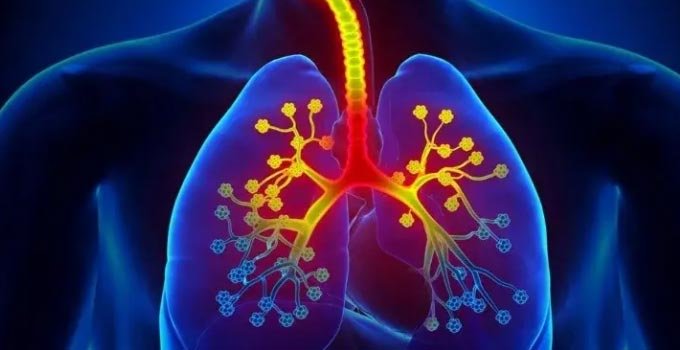Understanding Asthma: Symptoms, Causes, and Treatments

Table of Contents
What is Asthma?
Asthma is a chronic respiratory condition that affects the airways in the lungs. It is characterized by inflammation and narrowing of the air passages, resulting in symptoms such as coughing, wheezing, shortness of breath, and chest tightness. These symptoms can range from mild to severe and may occur intermittently or persistently.
During an asthma episode or “attack,” the muscles around the airways tighten, causing the air passages to become narrower. Additionally, the lining of the airways becomes inflamed and produces excess mucus, further obstructing the flow of air. These factors make it difficult for individuals with asthma to breathe properly.
Asthma is a complex condition with various triggers and underlying causes. Some common triggers include allergies (such as pollen, dust mites, or pet dander), respiratory infections, exercise, cold air, irritants (such as smoke or strong odors), and emotional factors (like stress or anxiety). Each person with asthma may have different triggers, and it is important to identify and avoid them to prevent asthma symptoms.
The exact cause of asthma is not fully understood, but it is believed to be a combination of genetic and environmental factors. People with a family history of asthma or allergies are more likely to develop the condition. Additionally, exposure to certain environmental factors, such as air pollution or tobacco smoke, can increase the risk of developing asthma.
While asthma cannot be cured, it can be effectively managed with appropriate treatment. The goal of asthma treatment is to control symptoms, prevent asthma attacks, and improve overall lung function. Treatment plans typically involve a combination of medications (such as inhalers or oral medications) and lifestyle modifications (including avoiding triggers and maintaining a healthy lifestyle).
It is crucial for individuals with asthma to work closely with their healthcare providers to develop a personalized asthma management plan. Regular monitoring, adherence to medication regimens, and proper education about asthma are essential for achieving optimal control over the condition and leading a healthy, active life.
- Asthma is a chronic respiratory condition characterized by inflammation and narrowing of the airways.
- Common symptoms include coughing, wheezing, shortness of breath, and chest tightness.
- Asthma attacks are triggered by various factors, such as allergies, infections, exercise, or irritants.
- Genetic predisposition and environmental factors contribute to the development of asthma.
- Asthma can be managed through a combination of medications and lifestyle modifications.
- Working closely with healthcare providers and following an asthma management plan is crucial for optimal control.
Common Symptoms of Asthma
Asthma is a chronic respiratory condition that affects millions of people worldwide. It is characterized by inflammation and narrowing of the airways, leading to symptoms such as coughing, wheezing, shortness of breath, and chest tightness. While the severity and frequency of these symptoms can vary from person to person, it is important to recognize and understand the common symptoms associated with asthma. Here are some of the most prevalent symptoms:
- Coughing: Persistent coughing, particularly at night or early morning, is a hallmark symptom of asthma. It may be accompanied by mucus production.
- Wheezing: Wheezing is a high-pitched whistling sound that occurs when air flows through narrowed airways. It is often heard during exhalation but can also be present during inhalation.
- Shortness of breath: Asthma can cause a feeling of breathlessness, as if you cannot take in enough air. This sensation can range from mild to severe, and it may be triggered by physical activity or exposure to allergens.
- Chest tightness: Many asthma sufferers experience a sensation of tightness or pressure in the chest. This can make breathing uncomfortable and may be accompanied by pain or a squeezing feeling.
- Difficulty sleeping: Asthma symptoms often worsen at night, leading to disrupted sleep. Nighttime coughing, wheezing, and shortness of breath can make it challenging to get a restful night’s sleep.
- Exercise intolerance: People with asthma may experience symptoms during or after physical exertion. This can limit their ability to participate in sports or engage in vigorous activities.
- Triggers: Asthma symptoms can be triggered by various factors, including allergens (such as pollen, dust mites, or pet dander), irritants (such as smoke or strong odors), cold air, respiratory infections, stress, and exercise.
If you experience any of these symptoms, it is essential to consult with a healthcare professional for a proper diagnosis and appropriate treatment. Asthma can be effectively managed with medication, lifestyle changes, and avoiding triggers. Understanding and recognizing the symptoms of asthma is the first step towards effective management and improved quality of life.
Causes and Triggers of Asthma
Asthma is a chronic respiratory condition that affects millions of people worldwide. While the exact cause of asthma is unknown, several factors can contribute to its development and trigger its symptoms. Understanding these causes and triggers is crucial for effectively managing the condition and improving the quality of life for asthma sufferers.
1. Genetics: Asthma tends to run in families, suggesting a genetic component. If one or both parents have asthma, their children are more likely to develop it as well. Specific genes associated with asthma have been identified, although the interaction between genetics and environmental factors is complex.
2. Allergens: Allergens are substances that can cause an allergic reaction in sensitive individuals. Common allergens that trigger asthma symptoms include pollen, dust mites, pet dander, mold spores, and certain foods. When exposed to these allergens, the immune system overreacts, leading to airway inflammation and constriction.
3. Environmental Factors: Environmental factors play a significant role in asthma development and triggers. Exposure to tobacco smoke, air pollution, chemical irritants, and occupational hazards can worsen asthma symptoms or even cause asthma in some cases. It is important to minimize exposure to these triggers to prevent asthma attacks.
4. Respiratory Infections: Respiratory infections, such as the common cold, flu, or respiratory syncytial virus (RSV), can trigger asthma symptoms. Infections lead to inflammation in the airways, making them more sensitive and prone to asthma attacks. Proper hygiene practices and avoiding sick individuals can help reduce the risk of respiratory infections.
5. Exercise and Physical Activity: Physical exertion and exercise are common triggers for asthma symptoms in many individuals, especially those with exercise-induced asthma. The increased breathing rate and colder, drier air during exercise can cause airway constriction and difficulty breathing. However, with proper management and medication, individuals with asthma can still engage in regular physical activity.
6. Emotional Factors: Strong emotions, such as stress, anxiety, or excitement, can trigger asthma symptoms in some individuals. Emotional stress can lead to changes in breathing patterns and increased sensitivity in the airways. Managing stress levels and practicing relaxation techniques can help prevent asthma flare-ups.
In conclusion, asthma is a complex condition with various causes and triggers. While genetics and allergens play a significant role, environmental factors, respiratory infections, exercise, and emotional factors can also contribute to the development and exacerbation of asthma symptoms. Identifying and avoiding triggers, along with proper medical management, can help individuals with asthma lead healthier and more fulfilling lives.
Effective Treatments for Asthma
Asthma is a chronic respiratory condition that affects millions of people worldwide. It is characterized by recurring episodes of wheezing, coughing, chest tightness, and shortness of breath. While there is no cure for asthma, there are several effective treatments available that can help manage the symptoms and improve the quality of life for individuals with this condition.
- Inhaled Corticosteroids: These are the most commonly prescribed medications for asthma. They work by reducing inflammation in the airways, making them less sensitive to triggers. Inhaled corticosteroids are taken daily to control symptoms and prevent asthma attacks.
- Bronchodilators: These medications help to relax the muscles around the airways, making it easier to breathe. Short-acting bronchodilators provide quick relief during an asthma attack, while long-acting bronchodilators are used for long-term control.
- Combination Inhalers: These inhalers contain both an inhaled corticosteroid and a long-acting bronchodilator. They are used for individuals whose asthma is not well controlled with just one medication.
- Leukotriene Modifiers: These medications block the effects of leukotrienes, which are chemicals that cause inflammation in the airways. They are taken orally and can be used as an alternative to inhaled corticosteroids.
- Immunomodulators: These medications help to modify the immune response, reducing the inflammation in the airways. They are typically used for individuals with severe asthma who do not respond well to other treatments.
In addition to medications, there are several other treatments that can be effective in managing asthma:
- Allergy Shots: For individuals with allergic asthma, allergy shots can help desensitize the immune system to specific allergens, reducing asthma symptoms.
- Lifestyle Modifications: Making certain lifestyle changes, such as avoiding triggers like smoke, dust, or pet dander, can help prevent asthma attacks.
- Asthma Action Plan: Creating a personalized asthma action plan with your healthcare provider can help you understand and manage your symptoms effectively.
- Regular Exercise: Engaging in regular physical activity can help strengthen the lungs and improve overall respiratory function.
- Education and Support: Participating in asthma education programs and seeking support from support groups or online communities can provide valuable information and emotional support.
It is important to note that the effectiveness of asthma treatments can vary from person to person. It is essential to work closely with a healthcare provider to develop an individualized treatment plan that suits your specific needs and helps you effectively manage your asthma.
Managing Asthma for Long-term Control
Asthma is a chronic respiratory condition that requires long-term management to ensure control and prevent flare-ups. While there is no cure for asthma, there are several strategies and treatments that can help individuals with asthma lead a normal, active life. Here are some key steps to manage asthma for long-term control:
- 1. Follow an Asthma Action Plan: Work with your healthcare provider to develop a personalized asthma action plan. This plan will outline your daily treatment, including medications and how to adjust them based on your symptoms. It will also provide guidance on what to do in case of an asthma attack.
- 2. Take Medications as Prescribed: It is crucial to take your prescribed medications regularly, even if you feel fine. Long-term control medications, such as inhaled corticosteroids, help reduce airway inflammation and prevent asthma symptoms. Quick-relief medications, such as bronchodilators, provide immediate relief during an asthma attack.
- 3. Identify and Avoid Triggers: Work with your healthcare provider to identify your asthma triggers, such as allergens, exercise, or certain medications. Once identified, take steps to avoid or minimize exposure to these triggers. This may involve making changes to your environment, such as using dust mite covers on bedding or avoiding outdoor activities during high pollen days.
- 4. Monitor Your Symptoms: Keep track of your asthma symptoms and peak flow readings using a peak flow meter. This will help you identify any patterns or triggers and allow you to adjust your treatment plan accordingly.
- 5. Lead a Healthy Lifestyle: Adopting a healthy lifestyle can have a positive impact on asthma management. Maintain a balanced diet, exercise regularly, get enough sleep, and manage stress. These factors can help boost your immune system and reduce the likelihood of asthma flare-ups.
- 6. Regular Check-ups: Schedule regular check-ups with your healthcare provider to monitor your asthma control, adjust medications if necessary, and address any concerns or questions you may have. Regular check-ups are essential to ensure your asthma management plan remains effective.
Remember, managing asthma for long-term control requires a proactive approach. By following these steps, you can minimize symptoms, prevent asthma attacks, and enjoy a better quality of life.


























